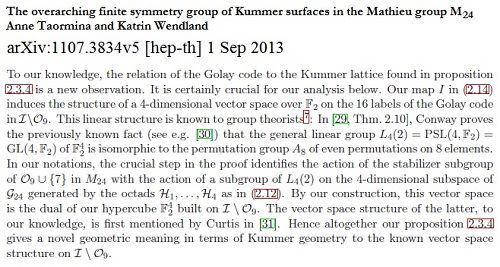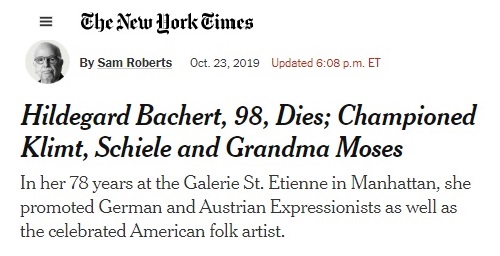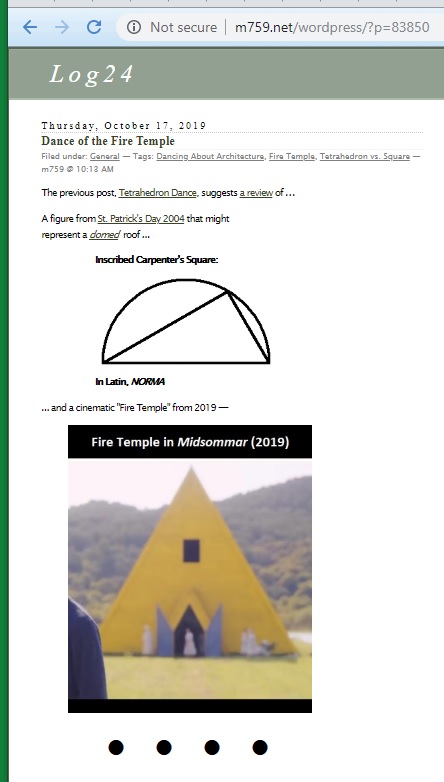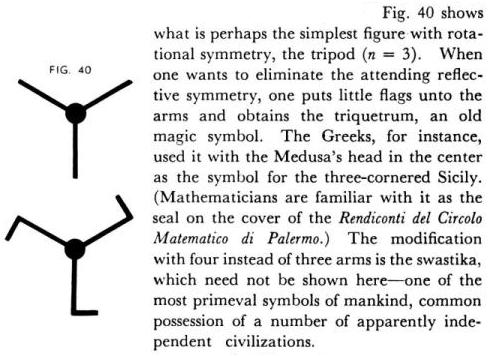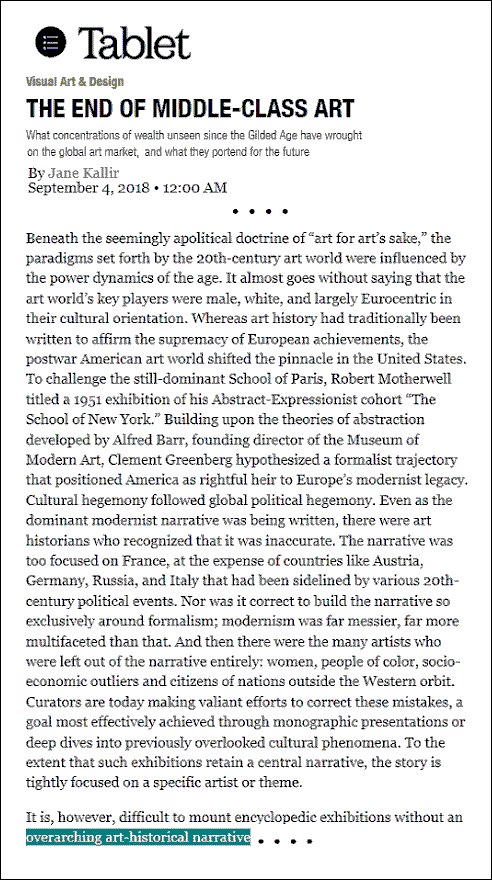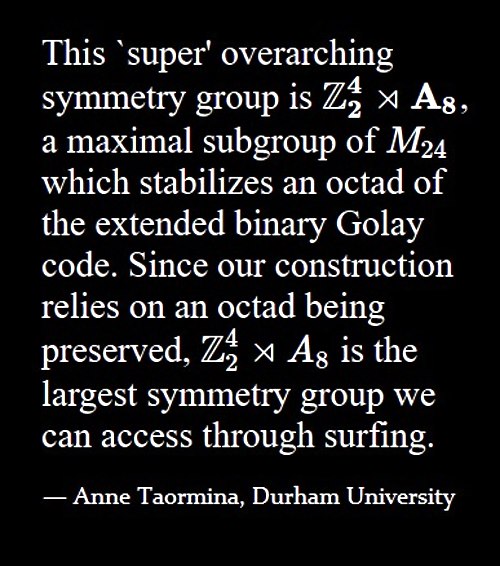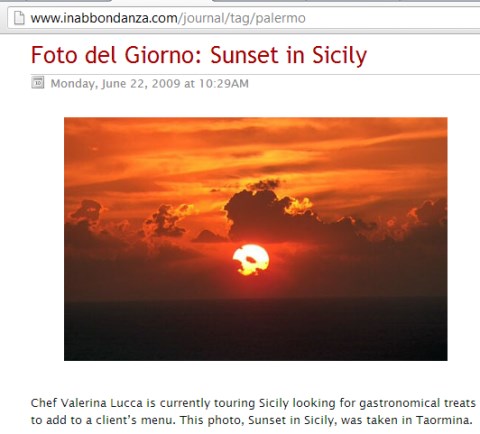
Tuesday, November 19, 2024
Monday, May 2, 2022
Overarching Rhetoric
" While quantum theory has proven to be supremely successful
since its development a century ago, physicists have struggled to
unify it with gravity to create one overarching ‘theory of everything.’ "
— News release 1-May-2022 from
Foundational Ouestions Institute, FQXi
See as well the new URL "overarching.group."
Sunday, March 6, 2022
Overarching Symmetries
By the Daniel J. Peterson whose Swarthmore honors thesis was quoted
here last night —
"What, then, is the relationship between theory-relative symmetries
(physical symmetries) and theory-independent symmetries
(overarching symmetries)? My statement of this problem is
a bit abstract, so let’s look at an example: classical Newtonian gravity
and classical electromagnetism . . . ."
— Prospects for a New Account of Time Reversal
by Daniel J. Peterson, Ph.D. dissertation, U. Mich., 2013, p. 16.
Another 2013 approach to the word "overarching" and sytmmetries —
Other terms of interest: Tenet , Nolanism , and Magic for Liars .
Thursday, December 16, 2021
Overarching Story
Six uses of "overarching" in an Aeon essay today —
- "an overarching story of life"
- "the overarching themes of thresholds and energy flows"
- "the overarching stages of human history"
- "an overarching evolutionary perspective"
- "overarching directional development"
- "the overarching laws of science"
See also "overarching" in this journal.
Wednesday, October 23, 2019
Overarching Narrative
In memory of a retired co-director of Galerie St. Etienne
who reportedly died on October 17 . . .
"It is… difficult to mount encyclopedic exhibitions
without an overarching art-historical narrative…."
— Jane Kallir, director of Galerie St. Etienne, in
https://www.tabletmag.com/jewish-arts-and-culture/
visual-art-and-design/269564/the-end-of-middle-class-art
An overarching narrative from the above death date —
See as well the previous post
and "Dancing at Lughnasa."
Monday, March 11, 2019
Overarching Metanarratives
See also "Overarching + Tesseract" in this journal. From the results
of that search, some context for the "inscape" of the previous post —
Friday, June 9, 2017
Overarching Theme
“Communications disorders were the overarching theme of my mother’s career.”
— Anne Louise Oaklander, daughter of a famed autism expert, Isabelle Rapin,
who reportedly died at 89 on May 24.
See also a post on Mark Zuckerberg's recent Harvard commencement address.
Some background — Overarching in this journal.
Friday, February 26, 2016
Overarching
"The study of social memory allows scholars to
understand how different memories form within
a collective group, thus exploring the societal
and ideological elements of disparate groups
that form the over-arching memory of Melkisedeq."
— The Melkisedeq Memoirs , by Cale Staley,
2015 master's thesis at the University of Iowa
Elements of groups that I prefer —
"Right through hell
there is a path…."
— Malcolm Lowry,
Under the Volcano
Thursday, December 3, 2015
Overarching Symmetry
From p. 34 of the preprint "Snapshots of Conformal Field Theory,"
by Katrin Wendland, arXiv, 11 April 2014 —

50. Gannon, T.: Much ado about Mathieu (arXiv:1211.5531 [math.RT])
85. Taormina, A., Wendland, K.: The overarching finite symmetry group
of Kummer surfaces in the Mathieu group M24. JHEP 08, 125 (2013)
86. Taormina, A., Wendland, K.: Symmetry-surfing the moduli space
of Kummer K3s (arXiv:1303.2931 [hep-th])
87. Taormina, A., Wendland, K.: A twist in the M24 moonshine story
(arXiv:1303.3221 [hep-th])
The Wendland paper was published on Jan. 7, 2015, in
Mathematical Aspects of Quantum Field Theories ,
edited by Damien Calaque and Thomas Strobl
(Springer Mathematical Physics Studies), pages 89-129.
Thursday, September 10, 2015
Super Overarching Symmetry
Thursday, March 12, 2015
Overarching Symmetry*
Monday, February 9, 2015
Overarching Symmetry
Continued from earlier posts.
|
The Washington Post online yesterday: "Val Logsdon Fitch, the Nebraska rancher’s son who shared the Nobel Prize for detecting a breakdown in the overarching symmetry of physical laws, thus helping explain how the universe evolved after the Big Bang, died Feb. 5 in Princeton, N.J. He was 91. His death was confirmed by Princeton University, where he had been a longtime faculty member and led the physics department for several years. Dr. Fitch and his Princeton colleague James Cronin received the Nobel Prize in physics in 1980 for high-energy experiments conducted in 1964 that overturned fundamental assumptions about symmetries and invariances that are characteristic of the laws of physics." — By Martin Weil |
Fans of synchronicity may prefer some rather
ig -Nobel remarks quoted here on the date
of Fitch's death:
"The Harvard College Events Board presents
Harvard Thinks Big VI, a night of big ideas
and thinking beyond traditional boundaries.
On Thursday February 5th at 8 pm in
Sanders Theatre …."
— Log24 post The Big Spielraum
Sunday, June 23, 2024
In Search of the Rainbow Bridge
Kate felt quite dizzy. She didn't know exactly what it was
that had just happened, but she felt pretty damn certain that
it was the sort of experience that her mother would not have
approved of on a first date.
"Is this all part of what we have to do to go to Asgard?"
she said. "Or are you just fooling around?"
"We will go to Asgard...now," he said.
At that moment he raised his hand as if to pluck an apple,
but instead of plucking he made a tiny, sharp turning movement.
The effect was as if he had twisted the entire world through a
billionth part of a billionth part of a degree. Everything
shifted, was for a moment minutely out of focus, and then
snapped back again as a suddenly different world.
— Douglas Adams, The Long Dark Tea-Time of the Soul
|
Overarching Symmetries, Theory Change, and Ontology "Overarching symmetries help us to determine which new theories should replace older, falsified theories. Typically, when an earlier theory has been rejected and physicists are searching for a new theory to replace it, physicists don't just start from scratch. They assume that many of the features of the old theory were, in fact, correct, assuming the theory in question had a history of empirical successes. The old theory must have gotten something right to be successful, so since new theories should be strictly better than the theories they replace, we need a way to identify those successful features of our old theories and carry those features over into our new theories. Successful features of older theories can thus constrain what good candidates for these theories' replacements should look like." — Daniel Peterson, "Physical Symmetries, Overarching Symmetries, and Consistency" |
Tuesday, August 30, 2022
Space Notes
Saturday, February 5, 2022
Hexagram 61 Revisited
The online New York Times today reporting a Jan. 29 death:
"Mr. Dylan asked Mr. Lay to back him on the title track
of his album “Highway 61 Revisited.” In addition to
playing drums, Mr. Lay played a toy whistle on the song’s
memorable opening."
— Richard Sandomir, Feb. 5, 2022, 2:06 p.m. ET
The above link yields a March 11, 2019, YouTube upload:
Some may prefer the theology of Hexagram 61.
“‘Oracle, why did you write
The Grasshopper Lies Heavy?
What are we supposed to learn?'”
— Philip K. Dick
“She began throwing the coins.“
Other remarks from the above
YouTube upload date — March 11, 2019 —
Saturday, January 29, 2022
Tuesday, December 21, 2021
Raiders of the Inarticulate . . .
. . . Continues.
". . . thematic preoccupations with binaries
(free will and destiny,
fact and fiction,
conscious and unconscious,
desire and fear)
and with the overarching notion
that stories become real
when they profoundly stir
one’s heart and mind.
These elements aren’t dramatized
as much as bluntly articulated . . . ."
— Nick Schager, thedailybeast.com, Dec. 21, 2021
Friday, October 8, 2021
Monday, November 30, 2020
Saturday, March 7, 2020
The “Octad Group” as Symmetries of the 4×4 Square
From "Mathieu Moonshine and Symmetry Surfing" —
(Submitted on 29 Sep 2016, last revised 22 Jan 2018)
by Matthias R. Gaberdiel (1), Christoph A. Keller (2),
and Hynek Paul (1)
(1) Institute for Theoretical Physics, ETH Zurich
(2) Department of Mathematics, ETH Zurich
https://arxiv.org/abs/1609.09302v2 —
"This presentation of the symmetry groups Gi is
particularly well-adapted for the symmetry surfing
philosophy. In particular it is straightforward to
combine them into an overarching symmetry group G
by combining all the generators. The resulting group is
the so-called octad group
G = (Z2)4 ⋊ A8 .
It can be described as a maximal subgroup of M24
obtained by the setwise stabilizer of a particular
'reference octad' in the Golay code, which we take
to be O9 = {3,5,6,9,15,19,23,24} ∈ 𝒢24. The octad
subgroup is of order 322560, and its index in M24
is 759, which is precisely the number of
different reference octads one can choose."
This "octad group" is in fact the symmetry group of the affine 4-space over GF(2),
so described in 1979 in connection not with the Golay code but with the geometry
of the 4×4 square.* Its nature as an affine group acting on the Golay code was
known long before 1979, but its description as an affine group acting on
the 4×4 square may first have been published in connection with the
Cullinane diamond theorem and Abstract 79T-A37, "Symmetry invariance in a
diamond ring," by Steven H. Cullinane in Notices of the American Mathematical
Society , February 1979, pages A-193, 194.
* The Galois tesseract .
Update of March 15, 2020 —
Conway and Sloane on the "octad group" in 1993 —

Wednesday, October 23, 2019
Art-Historical Narrative*
"Leonardo was something like what we now call a Conceptual artist,
maybe the original one. Ideas — experiments, theories — were
creative ends in themselves."
— Holland Cotter in the online New York TImes this evening
From other Log24 posts tagged Tetrahedron vs. Square —
* Phrase from the previous post, "Overarching Narrative."
Wednesday, September 5, 2018
Midnight Art
See also 12 AM Sept. 4 in this journal, "Identity Crisis."
Related material — "Overarching" in this journal.
Update of 4:12 AM ET —
The name of the New Yorker artist in the Identity Crisis post,
Tamara Shopsin, has now been added to the illustrated excerpt.
See as well . . .
https://www.nytimes.com/2018/09/04/obituaries/
kenny-shopsin-dead.html.
itemprop="datePublished"
content="2018-09-04T22:17:59.000Z"
Monday, April 23, 2018
Super Symmetry Surfing
Saturday, August 19, 2017
App
From a trailer for the 2013 Dutch film "App" —
From the online New York Times yesterday —
See also Overarching + Symmetry in this journal.
Sunday, May 28, 2017
Freeze Frame
In memory of John Severson, the founder of Surfer magazine —
"Freeze-frame surfer, and as a live Hendrix 'E Z Rider' blares
over the soundtrack, the surfer lifts his arms and rises like Christ
into the sky."
— Rolling Stone , August 5, 1971, on the film Rainbow Bridge
Severson reportedly died on Friday, May 26, 2017.
For a rather different sort of surfing, see this journal on that date.
Friday, May 26, 2017
Taormina Test

Mark Zuckerberg in a commencement speech
at Harvard yesterday —
"Movies and pop culture get this all wrong.
The idea of a single eureka moment
is a dangerous lie. It makes us feel inadequate
since we haven’t had ours. It prevents people
with seeds of good ideas from getting started.
Oh, you know what else movies get wrong about
innovation? No one writes math formulas on glass.
That’s not a thing."
The Thing from Taormina —
Thursday, February 23, 2017
Bullshit Studies
" The origin of new ways of doing things may often be
a disciplinary crisis. The definition of such a crisis
provided by Barry Mazur in Mykonos (2005) applies
equally well to literary creation. '[A crisis occurs] when
some established overarching framework, theoretical
vocabulary or procedure of thought is perceived as
inadequate in an essential way, or not meaning
what we think it means.' "
— Circles Disturbed :
The Interplay of Mathematics and Narrative
Edited by Apostolos Doxiadis & Barry Mazur
Princeton University Press, 2012. See
Chapter 14, Section 5.1, by Uri Margolin.
See also "overarching" in this journal.
Saturday, February 18, 2017
Not Strange Enough?
Peter Woit today discusses a book by one Zeeya Merali:
Some earlier remarks by Merali:
Zeeya Merali in Nature on 28 August 2013 —
"… a small band of researchers who think that
the usual ideas are not yet strange enough.
If nothing else, they say, neither of the two great
pillars of modern physics — general relativity,
which describes gravity as a curvature of space
and time, and quantum mechanics, which governs
the atomic realm — gives any account for
the existence of space and time.
. . . .
'All our experiences tell us we shouldn't have two
dramatically different conceptions of reality —
there must be one huge overarching theory,' says
Abhay Ashtekar, a physicist at Pennsylvania State
University in University Park."
See as well Overarching and Doctor Strange in this journal.
Monday, September 12, 2016
The Kummer Lattice
The previous post quoted Tom Wolfe on Chomsky's use of
the word "array."
An example of particular interest is the 4×4 array
(whether of dots or of unit squares) —
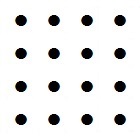
 .
.
Some context for the 4×4 array —
The following definition indicates that the 4×4 array, when
suitably coordinatized, underlies the Kummer lattice .

Further background on the Kummer lattice:
Alice Garbagnati and Alessandra Sarti,
"Kummer Surfaces and K3 surfaces
with $(Z/2Z)^4$ symplectic action."
To appear in Rocky Mountain J. Math. —
The above article is written from the viewpoint of traditional
algebraic geometry. For a less traditional view of the underlying
affine 4-space from finite geometry, see the website
Finite Geometry of the Square and Cube.
Some further context …
"To our knowledge, the relation of the Golay code
to the Kummer lattice … is a new observation."
— Anne Taormina and Katrin Wendland,
"The overarching finite symmetry group of
Kummer surfaces in the Mathieu group M24 "
As noted earlier, Taormina and Wendland seem not to be aware of
R. W. H. T. Hudson's use of the (uncoordinatized*) 4×4 array in his
1905 book Kummer's Quartic Surface. The array was coordinatized,
i.e. given a "vector space structure," by Cullinane eight years prior to
the cited remarks of Curtis.
* Update of Sept. 14: "Uncoordinatized," but parametrized by 0 and
the 15 two-subsets of a six-set. See the post of Sept. 13.
Monday, May 23, 2016
Springer
In memory of the late mathematician John Nash
and of the late actor Alan Young ...
A Talking Horse —
What the horse says: "First online: 28 August 2013."
See also Overarching, Psychonauts, and Spider Tale in this journal.
Friday, December 4, 2015
Scholium
"Encouraged by Proposition 5, one may hope…."
— Katrin Wendland in the previous post
Related material: Euclid Book I, Proposition 5.
Wednesday, September 9, 2015
Death Link
Continued from a post of August 20, 2015 —
|
(Continued) See posts of August 9, 2015. |
The death link above leads to an obituary for one
"John Henry Holland, Who Computerized Evolution."
A book by Holland published July 13, 2012, by The MIT Press —
Signals and Boundaries
|
How nice to have an overarching framework.
Monday, May 25, 2015
A Stitch in Time
The most recent version of a passage
quoted in posts tagged "May 19 Gestalt" —
"You've got to pick up every stitch." — Donovan
Sunday, May 17, 2015
Friday, March 13, 2015
Mathieu Moonshine
(Continued from yesterday's "earlier references" link.)
Yesterday at the Simons Foundation's Quanta Magazine :
See also earlier Log24 references to Mathieu moonshine .
I do not know the origin of this succinct phrase, taken from
an undated web page of Anne Taormina.
Monday, June 10, 2013
Galois Coordinates
Today's previous post on coordinate systems
suggests a look at the phrase "Galois coordinates."
A search shows that the phrase, though natural,
has apparently not been used before 2011* for solutions
to what Hermann Weyl called "the relativity problem."
A thorough historical essay on Galois coordinatization
in this sense would require more academic resources
than I have available. It would likely describe a number
of applications of Galois-field coordinates to square
(and perhaps to cubical) arrays that were studied before
1976, the date of my Diamond Theory monograph.
But such a survey might not find any such pre-1976
coordinatization of a 4×4 array by the 16 elements
of the vector 4-space over the Galois field with two
elements, GF(2).
Such coordinatizations are important because of their
close relationship to the Mathieu group M 24 .
See a preprint by Anne Taormina and Katrin Wendland,
"The overarching finite symmetry group of Kummer
surfaces in the Mathieu group M 24 ," with its remark
denying knowledge of any such coordinatization
prior to a 1989 paper by R. T. Curtis.
Related material:
Some images related to Galois coordinates, excerpted
from a Google search today (click to enlarge)—
* A rather abstract 2011 paper that uses the phrase
"Galois coordinates" may have some implications
for the naive form of the relativity problem
related to square and cubical arrays.
Sunday, June 9, 2013
Sicilian Reflections
(Continued from Sept. 22, 2011)
See Taormina in this journal, and the following photo of "Anne Newton"—
Click photo for context.
Related material:
"Super Overarching" in this journal,
a group of order 322,560, and…

See also the MAA Spectrum program —
— and an excerpt from the above book:
Sunday, May 19, 2013
Priority Claim
From an arXiv preprint submitted July 18, 2011,
and last revised on March 11, 2013 (version 4):
"By our construction, this vector space is the dual
of our hypercube F24 built on I \ O9. The vector space
structure of the latter, to our knowledge, is first
mentioned by Curtis in [Cur89]. Hence altogether
our proposition 2.3.4 gives a novel geometric
meaning in terms of Kummer geometry to the known
vector space structure on I \ O9."
[Cur89] reference:
R. T. Curtis, "Further elementary techniques using
the miracle octad generator," Proc. Edinburgh
Math. Soc. 32 (1989), 345-353 (received on
July 20, 1987).
— Anne Taormina and Katrin Wendland,
"The overarching finite symmetry group of Kummer
surfaces in the Mathieu group M 24 ,"
arXiv.org > hep-th > arXiv:1107.3834
"First mentioned by Curtis…."
No. I claim that to the best of my knowledge, the
vector space structure was first mentioned by me,
Steven H. Cullinane, in an AMS abstract submitted
in October 1978, some nine years before the
Curtis article.
|
Update of the above paragraph on July 6, 2013—
No. The vector space structure was described by
The vector space structure as it occurs in a 4×4 array |
See Notes on Finite Geometry for some background.
See in particular The Galois Tesseract.
For the relationship of the 1978 abstract to Kummer
geometry, see Rosenhain and Göpel Tetrads in PG(3,2).
Wednesday, May 1, 2013
The Crosswicks Curse
"There is such a thing as a tesseract." —A novel from Crosswicks
Related material from a 1905 graduate of Princeton,
"The 3-Space PG(3,2) and Its Group," is now available
at Internet Archive (1 download thus far).
The 3-space paper is relevant because of the
connection of the group it describes to the
"super, overarching" group of the tesseract.
Tuesday, April 30, 2013
Logline
Found this morning in a search:
A logline is a one-sentence summary of your script.
www.scriptologist.com/Magazine/Tips/Logline/logline.html
It's the short blurb in TV guides that tells you what a movie
is about and helps you decide if you're interested …
The search was suggested by a screenwriting weblog post,
"Loglines: WHAT are you doing?".
What is your story about?
No, seriously, WHAT are you writing about?
Who are the characters? What happens to them?
Where does it take place? What’s the theme?
What’s the style? There are nearly a million
little questions to answer when you set out
to tell a story. But it all starts with one
super, overarching question.
What are you writing about? This is the first
big idea that we pull out of the ether, sometimes
before we even have any characters.
What is your story about?
The screenwriting post was found in an earlier search for
the highlighted phrase.
The screenwriting post was dated December 15, 2009.
What I am doing now is checking for synchronicity.
This weblog on December 15, 2009, had a post
titled A Christmas Carol. That post referred to my 1976
monograph titled Diamond Theory .
I guess the script I'm summarizing right now is about
the heart of that theory, a group of 322,560 permutations
that preserve the symmetry of a family of graphic designs.
For that group in action, see the Diamond 16 Puzzle.
The "super overarching" phrase was used to describe
this same group in a different context:
This is from "Mathieu Moonshine," a webpage by Anne Taormina.
A logline summarizing my approach to that group:
Finite projective geometry explains
the surprising symmetry properties
of some simple graphic designs—
found, for instance, in quilts.
The story thus summarized is perhaps not destined for movie greatness.
Saturday, April 27, 2013
Mark and Remark
“Fact and fiction weave in and out of novels like a shell game.” —R.B. Kitaj
Not just novels.
Fact:
The mark preceding A8 in the above denotes the semidirect product.
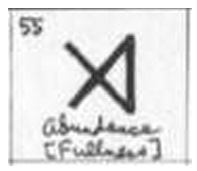 |
Symbol from the box-style I Ching (Cullinane, 1/6/89). This is Hexagram 55, “Abundance [Fullness].” |
The mathematical quote, from last evening’s Symmetry, is from Anne Taormina.
The I Ching remark is not.
Another version of Abbondanza —
Fiction:
Found in Translation and the giorno June 22, 2009, here.
Friday, April 26, 2013
Symmetry
Anne Taormina on Mathieu Moonshine —
This is, of course, the same group (of order 322,560) underlying the Diamond 16 Puzzle.
Sunday, March 17, 2013
Back to the Present
The previous post discussed some tesseract–
related mathematics from 1905.
Returning to the present, here is some arXiv activity
in the same area from March 11, 12, and 13, 2013.
